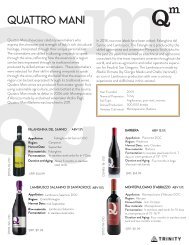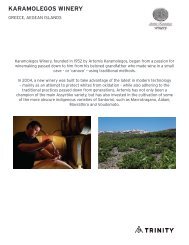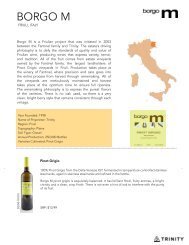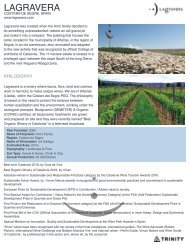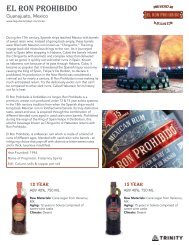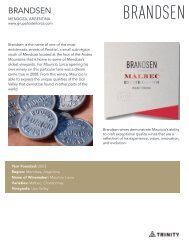Letter to Chef Phelan
You also want an ePaper? Increase the reach of your titles
YUMPU automatically turns print PDFs into web optimized ePapers that Google loves.
HISTORY IN A GLASS ~ FALERNIAN / FALANGHINA<br />
Falernian. One of the most important and interesting wines in his<strong>to</strong>ry.<br />
Coveted by the citizens of ancient Rome, mentioned by Emperor Marcus<br />
Aurelius in his famous Meditations, celebrated in the poems of Horace,<br />
immortalized in the early Roman novel Satyricon, poured <strong>to</strong> <strong>to</strong>ast Julius<br />
Caesar’s triumphant return from his conquest of Spain, and named by Pliny<br />
the Elder as “supreme above all other wines”.<br />
The Night Pompeii Died: Falernian was a best-seller in ancient<br />
Rome for hundreds of years, particularly in the ill-fated Roman City of<br />
Pompeii. In the ruins of that city, buried and perfectly preserved under<br />
twenty feet of volcanic ash (deposited when Mount Vesuvius erupted on a<br />
warm August evening in the year 79), archeologists have uncovered a 2,000-<br />
year-old wine bar known as Hedonus. It speaks <strong>to</strong> the early popularity of the<br />
Falernian wine. In a chamber below the street level stands a marble counter<br />
designed <strong>to</strong> hold large clay pitchers filled with wine. Dozens of the terracotta<br />
wine pitchers were found, with remnants of the wine still identifiable <strong>to</strong><br />
modern archeologists. There, on the wall above the marble bar, an ancient<br />
color painting of the wine pitchers is inscribed with the menu and price list:<br />
For one you can drink wine.<br />
For two you can drink the best wine.<br />
For four you can drink Falernian.<br />
Today, we believe that the Falernian wine was produced from grapes grown<br />
in the volcanic soil surrounding Vesuvius... particularly in the vineyard area<br />
known as Campi Flegrei (field of fire). Wine his<strong>to</strong>rians theorize that the<br />
Falernian wine was fermented from the ancient wine grape Falanghina,<br />
which is known <strong>to</strong> have grown in the Campi Flegrei region as far back as<br />
700 b.c. - and reaches its pinnacle when grown in rich volcanic soil.<br />
Falenghina has now emerged as a cult wine on the Campania coast<br />
and in the city of Naples, and the word is spreading! The wine is a perfect<br />
complement <strong>to</strong> the local seafood and shellfish along the Campanian coast,<br />
and gaining recognition worldwide. Modern Falanghina is known for its<br />
citrus-blossom aromas, bitter orange and apple notes, crisp acidity, and<br />
hints of peach, honey, and almond in the finish. It is a dry wine that frames<br />
the flavors of fresh seafood like no other. While Falanghina has become<br />
more widely available, it is still difficult <strong>to</strong> find the rare bottlings from<br />
grapes grown in the richest volcanic soil of the Campi Flegrei. These are the<br />
most highly prized bottles.<br />
My favorite among them is the Cantine Astroni Falanghina Campi Flegrei<br />
Colle Imperatrice. This Falanghina is the archetype. It has just won the first<br />
“Tre Bicchiere” award from Gambero Rosso, placing it among the few elite<br />
wines in all of Italy <strong>to</strong> receive their highest rating.<br />
Although the wine has never been available in this part of the world, we will<br />
be importing small amounts beginning in August of 2020. The first bottles<br />
<strong>to</strong> be opened in Ohio will be served (paired with a perfect seafood dish)<br />
at the Summer Wine Dinner at LUPO restaurant on Thursday, July 23rd.






